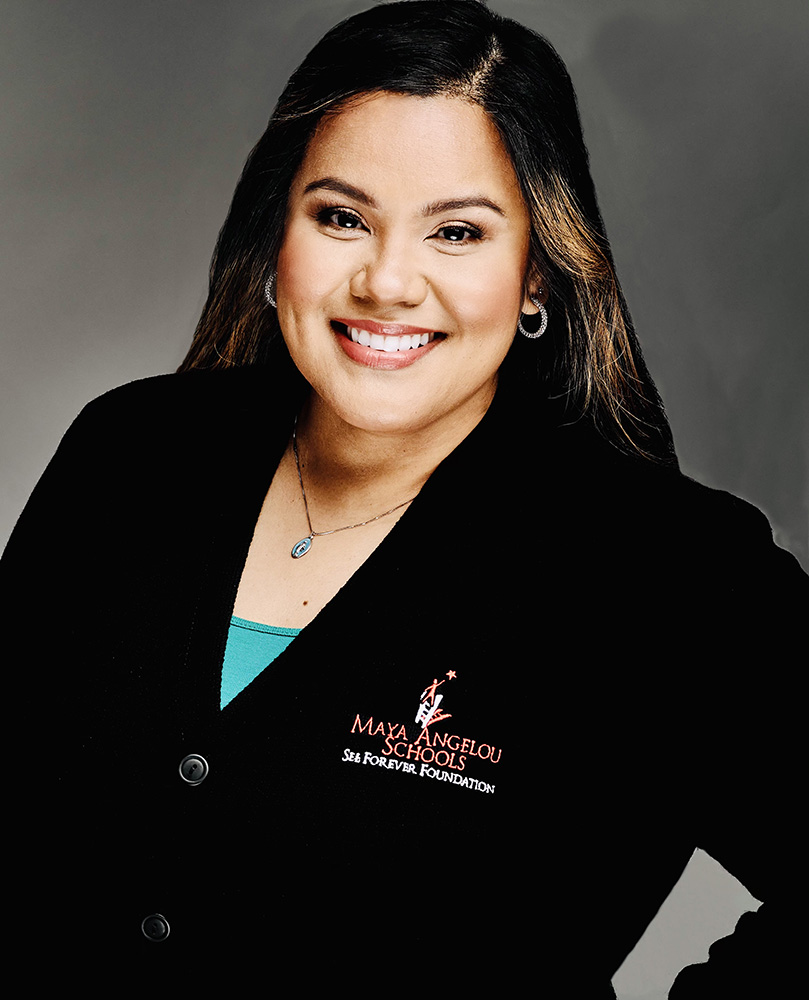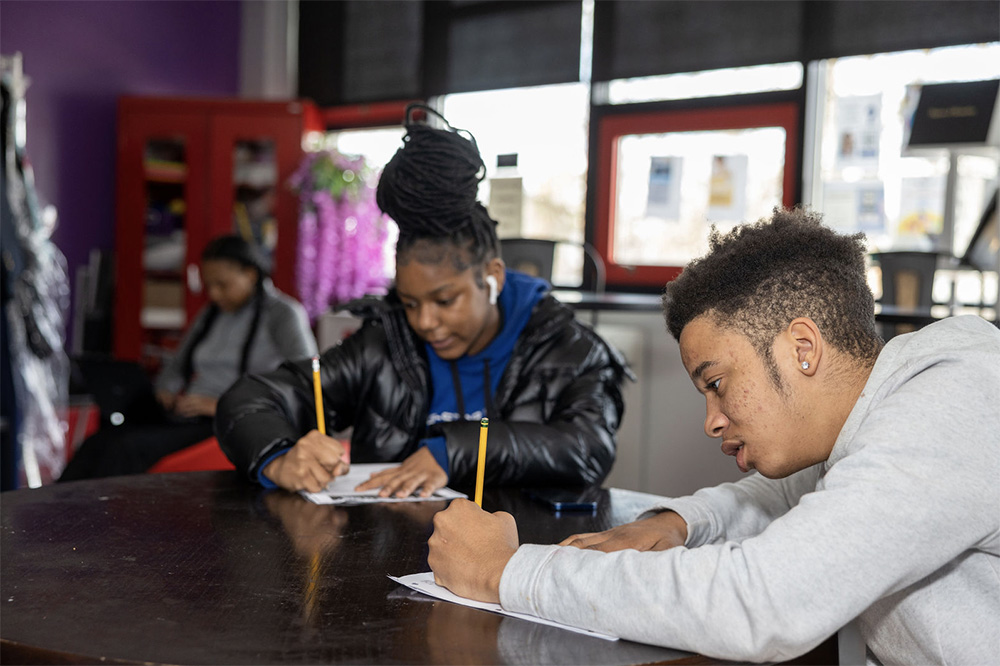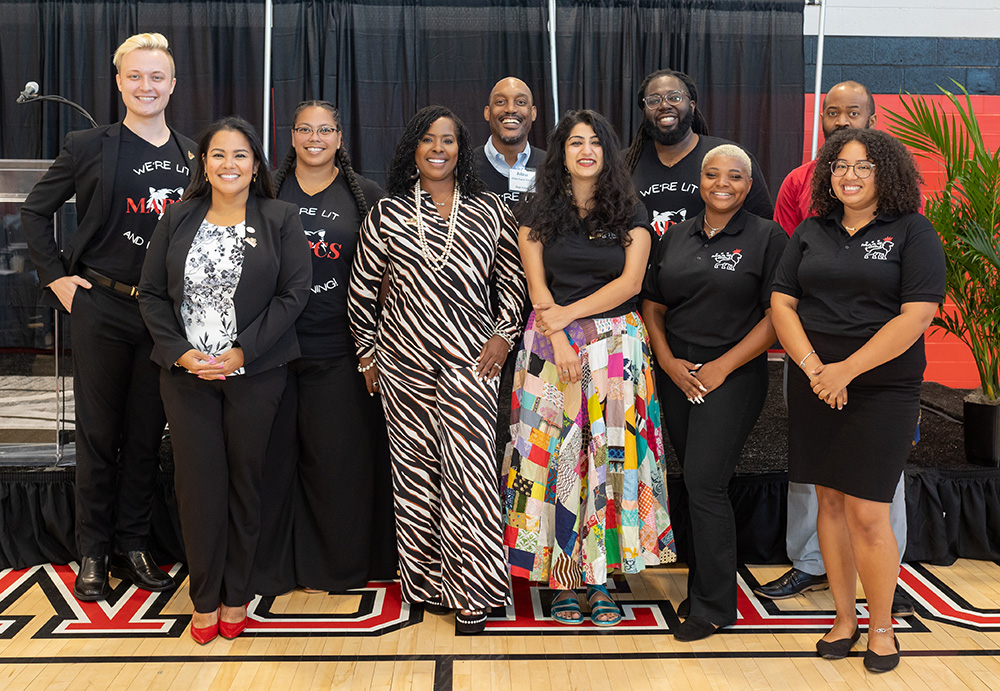Dr. Clarisse Mendoza Davis, ’08, runs toward the students that everyone else could not reach.

For longer than a quarter of a century, the Maya Angelou Schools in Washington, DC, have been fulfilling their mission that is closely aligned with the School of Education’s: teaching those most in need. They have worked with more than 5,000 students in underserved communities in Washington, DC, specifically those who have not succeeded in traditional schools, with more than 800 high school and GED graduates. Most notably, three school locations are physically housed inside juvenile detention centers preparing incarcerated young people for graduation and careers. In addition, there is the Maya Angelou Public Charter School, a high school in Northeast DC, and the Young Adult Learning Center for people ages 17 and up. See their 25th anniversary documentary here.
 CEO Dr. Clarisse Mendoza Davis, MA ’08, began her career with Maya as the Chief of Schools ensuring that principals had the necessary support to lead students to great academic and non-academic outcomes. She served “on the front line” as an interim principal at one campus, a pivotal time for her to work side-by-side with colleagues where she learned how to help clear obstacles, provide resources, and be proactive in the broader DC area for youth and their families.
CEO Dr. Clarisse Mendoza Davis, MA ’08, began her career with Maya as the Chief of Schools ensuring that principals had the necessary support to lead students to great academic and non-academic outcomes. She served “on the front line” as an interim principal at one campus, a pivotal time for her to work side-by-side with colleagues where she learned how to help clear obstacles, provide resources, and be proactive in the broader DC area for youth and their families.
The School of Education interviewed now-CEO Mendoza Davis about the amazing work her organization does.
 School of Education: Tell me about the Maya Angelou School’s mission and what makes your students special.
School of Education: Tell me about the Maya Angelou School’s mission and what makes your students special.
Dr. Clarisse Mendoza Davis: We run towards the students that everyone else could not reach. Our mission is to serve opportunity and justice-involved youth. Opportunity youth are often overaged and under credited, disconnected from school for quite some time, so they're returning to restart their journey toward earning a high school diploma or a GED. By justice-involved, I mean the detention facilities in DC that serve incarcerated young people with our teachers in Maya schools inside those facilities. We want schools to be coherent for students because prior to coming to us it's been pretty chaotic for them. We want it to be a restorative experience because if you've been suspended or expelled multiple times, if you've moved from school to school, there's trauma that comes with that. We want the school experience to be healing for our kids and young people. With that coherent wrap around, we help students by taking a personalized approach to learning where we prioritize wellness, both mental and physical. We want to make sure that you're ready for traditional post-secondary learning either immediately after you graduate or sometime in the future, but it's okay if you don't go to college. Many of our students and families say they want to work, so we are expanding our career and technical education programming so students are leaving with credentials and employment placements where they are either already, or set to, earn a family sustaining wage.
SOE: How did you come to know American University?
CMD: I started my practice in public education as a classroom English teacher through Teach for America, and the DC region had a partnership with AU's then-Graduate School of Education. While core members were teaching during the day, we would attend our graduate classes at night to earn our Master of Arts in Teaching. It was such an incredible experience – we gained from the real-world application of being able to apply theory to practice literally the day after class.
SOE: What was the most memorable part of attending what is now the School of Education?
CMD: One class that really stands out to me was the class on educational equity. I was working with ninth-grade English repeaters, which felt like it was a doomsday assignment, but it was actually one of my favorite groups with scholars trying for a second or third time to restart their journey towards graduation. Equity-centered practice really means getting to know and understand your students and then doing the very detailed and intentional work of meeting their personalized learning needs and it really aligns with what Dean Cheryl has been trying to do in her leadership at the School of Education. I expanded my toolkit through that equity-centered coursework to meet students where they were. It was an anchor in my career all the way to present day.
SOE: How did your time at American University prepare you for your career?
CMD: I eventually went on to earn my doctorate in systems-level education leadership – specifically superintendent preparation – but I don't think that would have been possible without making sure that I was a knowledgeable and effective instructional practitioner, teacher practitioner, and classroom practitioner. To this day, I can't imagine leading here at Maya or supporting our team and colleagues without having graduate study experience and pedagogical practice.
SOE: How do you see the education field evolving as far as opportunities and challenges for future teachers?
CMD: I'm reflecting all the way back to my practice as a classroom teacher when we were siloed from other non-teacher colleagues. If there are social emotional or mental health issues, other foundational needs not being met – like hunger or sleeping on somebody else's couch because mom kicked me out – working in silos is no longer the way to be an effective teacher. You have to team up effectively with other non-instructional colleagues in your school community to truly ‘wrap around’ a student and serve them in a way that's coherent. Help them stay engaged. Help them actually succeed. So the right course work today's Master’s in Teaching should include is a class on trauma-informed approaches, a class on social-emotional efficacy and how to integrate that into classroom instruction. I'd argue that even though we want our students digitally literate, this now means understanding how to use artificial intelligence to supplement the writing you produce to supplement your thinking as a student. A class on broader policy and equity issues that impact your students’ lives outside of school. You have to co-navigate all of that with your students in your classroom, but you can't just do it with your door closed. You have to be able to work with the social workers, guidance counselors, the school nurse, the community engagement specialist, the family engagement specialists, your principal, and your administration to really take that holistic approach. We've been doing that at Maya for the last 26 years and it feels like and Dean Cheryl has affirmed our practice that everyone else is kind of catching onto.
SOE: Two School of Education students pursuing their Child Development Associate (CDA) certifications are completing their field work at your school. How did this relationship come about?
CMD: As we expand our menu of career and technical education options, we're so excited when Dean Cheryl told us about the program. It is perfect because we have young people in our programs who are interested in serving as early childhood educators. It’s hard to add the capacity to our in-house team to create these opportunities, and we learned about the wrap-around support in the CDA program that mirrors the supports that our students have been getting while they're here. It was the recipe for a perfect partnership. We oftentimes court other partners for that additional support – that authentic relationship building – that some people assume that students don’t need after they graduate. They arguably need it even more to persist. We're looking forward to having more Maya graduates enroll and attend, hopefully going all the way through the pathway to a bachelor's degree. Our students tend to think about college through that typical lens like, “I'm gonna go away. I'm gonna have to take out all this financial aid.” They have reservations about that, so the CDA is the perfect approach to connect with professors, work online, and get right to their field experience, which really keeps our students engaged.

SOE: How did your schools address the social and emotional wellbeing of students, particularly after the COVID pandemic?
CMD: There was a triple pandemic: COVID, the economic fallout from COVID for students and their families, and there was escalating violence in our community during the pandemic as well. We were up against these really traumatic student experiences. We amplified what we already do here at Maya, virtually, with staff members in many of our schools, including those in secure facilities, still going in to teach in person. During and after the pandemic, every scholar enrolled here has had a social worker or clinical counselor that they see regularly to provide support and to continue to assess if there is a need for more intensive clinical and mental health supports. Part of our clinical approach is fully integrating with the rest of the school, including our classroom teachers, including social emotional learning into the daily classroom experience for our students.
SOE: If you could fix one thing in youth justice system what would that be?
CMD: There are so many young people who are incarcerated and actually do make excellent progress while in the facilities. All of that is for naught if we are not marrying the support to make sure that they stay on that trajectory in the immediate short term after release to the community, and in the longer term. The gap that we clearly see is that if you send a student back to the same school without the right coordinated supports, without somebody checking in, without caring adults, then the chance that they reoffend is pretty high.
In September, Maya will host a convening of practitioners across professional domains that support students and families with housing and nutrition, policymakers, lawmakers, scholars, and researchers, faith-based organizations. “From Silos to Solutions” will break down the barriers to coordinate supports for opportunity and justice-involved youth. Despite all of us trying in our respective silos, the status of crime is what it is, recidivism is still up, and so rather than waiting on someone to save them, this is how we're going to come together to fix it.
We here at Maya have taken it upon ourselves to provide more extended transition and support services to our scholars after they leave, but that takes bandwidth and capacity. Maya can't do it alone. We have the unique opportunity to be able to coordinate that here in DC that I think many of other jurisdictions or cities might not.
 SOE: Looking ahead at the priorities toward achieving Maya Angelou Schools’ goals, what other preparation are you doing to set your school up for success?
SOE: Looking ahead at the priorities toward achieving Maya Angelou Schools’ goals, what other preparation are you doing to set your school up for success?
CMD: We are receiving and welcoming the students that represent the opportunity achievement gap that exists in the in the traditional K-12 or adult education sector. If you look at our data over the last five years, we consistently – across all of our campuses – are helping seventy percent of our students meet their individual academic goals and non-academic goals. There's still that group that's the hardest to reach – a gap with within the gap – that we're trying to fill. Our mission is to figure out that. When the various entities here in DC, and I see this nationally as well, consider alternative schools or alternative approaches, they're patting us on the back for getting seventy percent of the hardest to serve there. We cannot rest right until every one of our students is on that trajectory to truly be happy and meet their goals. We’re making adjustments to our curriculum to make sure that it's totally trauma-informed, and that it's really engaging and culturally responsive, expanding our career and technical education menu to recruit more students into pathways right that put them on that positive post-secondary pathway. We're hoping that the innovations that we're trying out to really engage that thirty percent of students to codify those practices and then share them out. We've always been serving young people directly, but we're also hoping that with our playbook of 26 years we have practices to offer to other educators including those that are not alternative but want to meet the needs of students in a loving authentic an effective way. That's what's next for us.
SOE: Do you have any closing thoughts?
CMD: It's been a journey but the greatest privilege of my career to lead here and to serve here. But I think that AU’s School of Education taught me to be a reflective practitioner, always coming from a place of curiosity.
